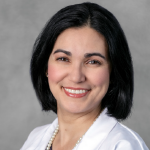Including Outreach in a Busy Schedule
In addition to her other roles, Dr. Del Rios Rivera is director of Social Emergency Medicine at the university. Most of her research is on resuscitation related to cardiac arrest, specifically focused on community preparedness and teaching bystander CPR and the proper use of automated external defibrillators. Her research also examines how geography plays a role in survival so that she and her colleagues can focus their efforts on communities with the highest risk of death. Her involvement with Illinois Unidos, she said, is like another full-time job.
On top of that, she and her husband, a law professor now teaching from home, have two sons, 11 and 14, both doing hybrid schooling. While she used to do a lot of work from her office to minimize distractions, at the time of this interview she was trying to avoid the office as much as possible for infection control, so the family had to restructure their setup at home to ensure they each had adequate space to work.
“You do what you have to do,” she said. “This is inconvenient, but I think that I’m, again, very privileged in that I have this flexibility. I feel for the parents that physically have to go to work and are also juggling having to help their children with online learning and making sure that they’re safe.”
Dr. Del Rios Rivera still works overnight shifts in the emergency department—“Sleep? What’s sleep?” she said—and continues her cardiac arrest research, now looking at national data sets and doing predictive modeling to understand how some communities manage cardiac arrest well versus communities that do not. She also mentors medical students through the Hispanic Center of Excellence and the Urban Health Program, some of whom assist with her COVID-19-related community service work specifically for the Latino community, like helping put together information sheets, delivering messaging, and engaging with communities.
Building Awareness Powered by Data
Dr. Del Rios Rivera became involved with Illinois Unidos after community members began organizing to look at the COVID-19 data in a different way. Since the Latino community knows her, they reached out when it became clear in April that Latino people were not being included in the narrative of disparities and cardiac arrest.
“There seemed to be an absence of discussion of the crisis that was already occurring in our communities,” she said.
Pages: 1 2 3 4 | Single Page





No Responses to “Combating COVID in Latino Communities”